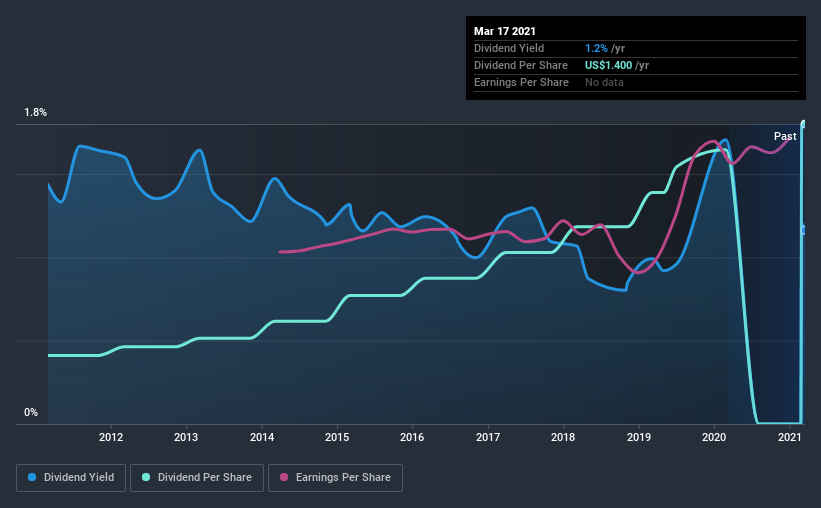- United States
- /
- Healthcare Services
- /
- NYSE:USPH
What To Know Before Buying U.S. Physical Therapy, Inc. (NYSE:USPH) For Its Dividend

Could U.S. Physical Therapy, Inc. (NYSE:USPH) be an attractive dividend share to own for the long haul? Investors are often drawn to strong companies with the idea of reinvesting the dividends. On the other hand, investors have been known to buy a stock because of its yield, and then lose money if the company's dividend doesn't live up to expectations.
A 1.2% yield is nothing to get excited about, but investors probably think the long payment history suggests U.S. Physical Therapy has some staying power. Some simple analysis can reduce the risk of holding U.S. Physical Therapy for its dividend, and we'll focus on the most important aspects below.
Explore this interactive chart for our latest analysis on U.S. Physical Therapy!

Payout ratios
Dividends are usually paid out of company earnings. If a company is paying more than it earns, then the dividend might become unsustainable - hardly an ideal situation. So we need to form a view on if a company's dividend is sustainable, relative to its net profit after tax. U.S. Physical Therapy paid out 13% of its profit as dividends, over the trailing twelve month period. We'd say its dividends are thoroughly covered by earnings.
In addition to comparing dividends against profits, we should inspect whether the company generated enough cash to pay its dividend. U.S. Physical Therapy's cash payout ratio last year was 4.5%. Cash flows are typically lumpy, but this looks like an appropriately conservative payout. It's positive to see that U.S. Physical Therapy's dividend is covered by both profits and cash flow, since this is generally a sign that the dividend is sustainable, and a lower payout ratio usually suggests a greater margin of safety before the dividend gets cut.
Consider getting our latest analysis on U.S. Physical Therapy's financial position here.
Dividend Volatility
One of the major risks of relying on dividend income, is the potential for a company to struggle financially and cut its dividend. Not only is your income cut, but the value of your investment declines as well - nasty. U.S. Physical Therapy has been paying dividends for a long time, but for the purpose of this analysis, we only examine the past 10 years of payments. This dividend has been unstable, which we define as having been cut one or more times over this time. During the past 10-year period, the first annual payment was US$0.3 in 2011, compared to US$1.4 last year. This works out to be a compound annual growth rate (CAGR) of approximately 16% a year over that time. U.S. Physical Therapy's dividend payments have fluctuated, so it hasn't grown 16% every year, but the CAGR is a useful rule of thumb for approximating the historical growth.
It's not great to see that the payment has been cut in the past. We're generally more wary of companies that have cut their dividend before, as they tend to perform worse in an economic downturn.
Dividend Growth Potential
Given that the dividend has been cut in the past, we need to check if earnings are growing and if that might lead to stronger dividends in the future. U.S. Physical Therapy has grown its earnings per share at 8.3% per annum over the past five years. With a decent amount of growth and a low payout ratio, we think this bodes well for U.S. Physical Therapy's prospects of growing its dividend payments in the future.
Conclusion
To summarise, shareholders should always check that U.S. Physical Therapy's dividends are affordable, that its dividend payments are relatively stable, and that it has decent prospects for growing its earnings and dividend. Firstly, we like that U.S. Physical Therapy has low and conservative payout ratios. Next, earnings growth has been good, but unfortunately the dividend has been cut at least once in the past. All things considered, U.S. Physical Therapy looks like a strong prospect. At the right valuation, it could be something special.
Companies possessing a stable dividend policy will likely enjoy greater investor interest than those suffering from a more inconsistent approach. Meanwhile, despite the importance of dividend payments, they are not the only factors our readers should know when assessing a company. Taking the debate a bit further, we've identified 1 warning sign for U.S. Physical Therapy that investors need to be conscious of moving forward.
If you are a dividend investor, you might also want to look at our curated list of dividend stocks yielding above 3%.
If you’re looking to trade U.S. Physical Therapy, open an account with the lowest-cost* platform trusted by professionals, Interactive Brokers. Their clients from over 200 countries and territories trade stocks, options, futures, forex, bonds and funds worldwide from a single integrated account. Promoted
New: AI Stock Screener & Alerts
Our new AI Stock Screener scans the market every day to uncover opportunities.
• Dividend Powerhouses (3%+ Yield)
• Undervalued Small Caps with Insider Buying
• High growth Tech and AI Companies
Or build your own from over 50 metrics.
This article by Simply Wall St is general in nature. It does not constitute a recommendation to buy or sell any stock, and does not take account of your objectives, or your financial situation. We aim to bring you long-term focused analysis driven by fundamental data. Note that our analysis may not factor in the latest price-sensitive company announcements or qualitative material. Simply Wall St has no position in any stocks mentioned.
*Interactive Brokers Rated Lowest Cost Broker by StockBrokers.com Annual Online Review 2020
Have feedback on this article? Concerned about the content? Get in touch with us directly. Alternatively, email editorial-team (at) simplywallst.com.
About NYSE:USPH
U.S. Physical Therapy
Operates and manages outpatient physical therapy clinics.
Excellent balance sheet with proven track record and pays a dividend.
Similar Companies
Market Insights
Community Narratives




